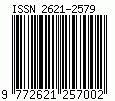Countering Journalist Curse in A Bourdieusian Perspective: Metajournalistic Discourse on Doxing in Remotivi Indonesia
DOI:
https://doi.org/10.12928/channel.v12i1.649Keywords:
bourdieu, doxing, Indonesian journalism, metajournalistic discourse, media ethicAbstract
This research explores the phenomenon of doxing as a digital form of attack against journalists, reflecting a shift from physical threats to digital harassment facilitated by the accessibility of digital media. Utilizing a metajournalistic discourse approach, this study examines how Indonesian journalists perceive and respond to the pressures of doxing within the framework of their professional practices and identities. By analyzing metajournalistic discourse documents from the Remotivi website, this research positions journalists as both victims and defenders within their field, facing pressures from both the political and economic spheres. Pierre Bourdieu’s theoretical constructs of the journalistic field, capital, and habitus are employed to interpret the responses of journalists to these digital threats. The findings indicate that doxing represents a significant external influence, perpetuating a high degree of heteronomy within the journalistic field. However, there also exists a discursive resistance among journalists, characterized by efforts to define and uphold a journalistic identity aligned with autonomy and ethical norms. This study highlights the need for greater cybersecurity awareness and protections for journalists, emphasizing the importance of maintaining journalistic integrity in the face of evolving digital threats.
References
Alhakim, A. (2022). Urgensi Perlindungan Hukum terhadap Jurnalis dari Risiko Kriminalisasi UU Informasi dan Transaksi Elektronik di Indonesia. Jurnal Pembangunan Hukum Indonesia, 4(1), 89–106. https://doi.org/10.14710/jphi.v4i1.89-106
Banimal, A. H., Juniarto, D., & Ningtyas, I. (2020). Peningkatan Serangan Doxing dan Tantangan Perlindunganya di Indonesia. Jakarta.
Bazaco, Á., Redondo, M., & Sánchez-García, P. (2019). Clickbait as a strategy of viral journalism: conceptualisation and methods. Revista Latina de Comunicación Social, 74, 94–115. https://doi.org/10.4185/RLCS-201
Benson, R. (2006). News media as a “journalistic field”: What Bourdieu adds to new institutionalism, and vice versa. Political Communication, 23(2), 187–202. https://doi.org/10.1080/10584600600629802
Blanchett Neheli, N. (2018). News by Numbers: The evolution of analytics in journalism. Digital Journalism, 6(8), 1041–1051. https://doi.org/10.1080/21670811.2018.1504626
Bourdieu, P. (1984). Distinction: A Social Critique of the Judgement of Taste. Massachusetts: Massachusetts: Harvard University Press. ISBN: 9780674212770
Bourdieu, P. (1986). The Forms of Capital. In J. G. Richardson (Ed.), Handbook of Theory and Research for the Sociology of Education. Westport: Greenwood Press. https://www.marxists.org/reference/subject/philosophy/works/fr/bourdieu-forms-capital.htm
Bourdieu, P. (1993). The Field on Cultural Production: Essays on Art and Literature. Cambridge: Polity Press.
Bourdieu, P. (1998). On Television. New York: New Free Press. ISBN 1-56584-407-6
Bourdieu, P. (2004). The Political Field, the Social Science Field, and Journalistic Field. In R. Benson & E. Neveu (Eds.), Bourdieu and the Journalistic Field. Cambridge: Polity Press. ISBN 1-56584-407-6
Carlson, M. (2014). What’s All the Fuss About? Metajournalistic Discourse as Methodological Intervention in A Time of Media Upheaval. Qualitative Political Communication Research. Seattle: International Communication Association.
Carlson, M. (2016). Metajournalistic Discourse and the Meanings of Journalism: Definitional Control, Boundary Work, and Legitimation. Communication Theory, 26(4), 349–368. https://doi.org/10.1111/comt.12088
Champagne, P. (2005). The Double Dependency: The Journalistic Field Between Politics and Market. In R. Benson & E. Neveu (Eds.), Bourdieu and Journalistic Field. Cambridge: Polity Press. ISBN: 978-0-745-63386-2
Champagne, P. (2006). News Media as a ‘Journalistic Field’: What Bourdieu Adds to New Institutionalism, and Vice Versa. Political Communication, 23, 187–202. DOI:10.1080/10584600600629802
Champagne, P., & Marchetti, D. (2005). The Contamined Blood Scandal: Reframing Medical News. In R. Benson & E. Neveu (Eds.), Bourdieu and Journalistic Field. Cambridge: Polity Press.
Citron, D. K. (2014). Hate Crimes in Cyberspace. Cambridge: Harvard University Press. ISBN: 9780674659902
De Maeyer, J., & Holton, A. E. (2016). Why Linking Matters: A Metajournalistic Discourse Analysis. Journalism, 17(6), 776–794. https://doi.org/10.1177/1464884915579330
Douglas, D. M. (2016). Doxing: a conceptual analysis. Ethics and Information Technology, 18(3), 199–210. https://doi.org/10.1007/s10676-016-9406-0
Dvarkin, J. (2016). Column: Why click-bait will be the death of journalism. Retrieved February 5, 2023, from PBS website: https://www.pbs.org/newshour/economy/what-you-dont-know-about-click-bait-journalism-could-kill-you#.WEILpdHQL7w.twitter
Favarel-Garrigues, G., Tanner, S., & Trottier, D. (2020). Introducing digital vigilantism. Global Crime, 21(3–4), 189–195. https://doi.org/10.1080/17440572.2020.1750789
Ferrucci, P. (2018). Mo “Meta” Blues: How Popular Culture Can Act as Metajournalistic Discourse. International Journal of Communication, 12, 4821–4838.
Ferrucci, P. (2021). Joining the Team: Metajournalistic Discourse, Paradigm Repair, the Athletic and Sports Journalism Practice. Journalism Practice, 0(0), 1–19. https://doi.org/10.1080/17512786.2021.1907213
Gaizka, D. (2019). Jadi Wartawan Online itu Mesti Menguasai Kage Bunshin untuk Kejar Kuota Berita. Retrieved November 12, 2022, from Remotivi website: https://www.remotivi.or.id/di-balik-layar/557/jadi-wartawan-online-itu-mesti-menguasai-kage-bunshin-untuk-kejar-kuota-berita
Hansen, I., & Lim, D. J. (2019). Doxing democracy: influencing elections via cyber voter interference. Contemporary Politics, 25(2), 150–171. https://doi.org/10.1080/13569775.2018.1493629
Haryatmoko. (2003). Landasan Teoritis Gerakan Sosial Menurut Pierre Bourdieu: Menyingkap Kepalsuan Budaya Penguasa. Basis.
Hiltunen, I. (2019). Experiences of External Interference Among Finnish Journalists: Prevalence, methods and implications. Nordicom Review, 40(1), 3–21. https://doi.org/DOI:10.2478/nor-2018-0016
Jamil, S. (2020). Suffering in Silence: The Resilience of Pakistan’s Female Journalists to Combat Sexual Harassment, Threats and Discrimination. Journalism Pracrtice, 14(2), 150–170. https://doi.org/https://doi.org/10.1080/17512786.2020.1725599
Johnson, B. G., Bent, L., & Dade, C. (2020). An Ethic of Advocacy: Metajournalistic Discourse on the Practice of Leaks and Whistleblowing from Valerie Plame to the Trump Administration. Journal of Media Ethics: Exploring Questions of Media Morality, 35(1), 2–16. https://doi.org/10.1080/23736992.2020.1731314
Johnson, B. G., Thomas, R. J., & Fuzy, J. P. (2021). Beyond Journalism about Journalism: Amicus Briefs as Metajournalistic Discourse. Journalism Practice, 15(7), 937–954. https://doi.org/10.1080/17512786.2020.1758590
Komala, R. (2018). Editorial. Jurnal Dewan Pers, 18, 7–11.
Krisdinanto, N. (2014). Pierre Bourdieu, Sang Juru Damai. KANAL: Jurnal Ilmu Komunikasi, 2(2), 189. https://doi.org/10.21070/kanal.v2i2.300
Krisdinanto, N. (2023a). ‘ Clickbait ’ sebagai ‘ Darwinisme Informasi ’: Sebuah Uraian Konseptual. Expose: Jurnal Ilmu Komunikasi, 6(1), 16–27. https://doi.org/10.33021/exp.v6i1.4134
Krisdinanto, N. (2023b). Bourdieu dan Perspektif Alternatif Kajian Jurnalistik. Kawistara, 13(1), 136–156. https://doi.org/https://doi.org/10.22146/kawistara.75088
Lestari, R. D. (2017). Quality News dan Popular News Sebagai Trend Pemberitaan Media Online (Studi Deskriptif Kualitatif Trend Pemberitaan Quality News dan Popular News pada Media Online Nasional di Indonesia Periode 2016). CHANNEL: Jurnal Komunikasi, 5(1), 83–94. https://doi.org/10.12928/channel.v5i1.6355
Lexander, D. (2020). Nasib Jurnalis Olahraga Penggoreng Fanatisme Sepak Bola. Retrieved November 12, 2022, from Remotivi website: https://www.remotivi.or.id/di-balik-layar/640/nasib-jurnalis-olahraga-penggoreng-fanatisme-sepak-bola
Li, L. B. (2018). Data Privacy in the Cyber Age: Recommendations for Regulating Doxing and Swatting. Federal Communications Law Journal, 70(3). https://doi.org/http://dx.doi.org/10.2139/ssrn.3012266
Lune, H. & Berg, B. L. (2017). Qualitative Research Methods for the Social Sciences (9th Edition). In Pearson Education Limited. London: Pearson.
Mahbub, H. (2018). Media Digital: Antara Konten Penting atau Menarik. Retrieved November 20, 2022, from Remotivi website: https://www.remotivi.or.id/di-balik-layar/526/media-digital:-antara-konten-penting-atau-menarik
Manan, A. (2011). Upah Layak Jurnalis: Survey Upah Layak AJI di 16 Kota di Indonesia. Jakarta: Aliansi Jurnalis Independen (AJI) Indonesia.
Manan, A. (2013). Potret Pers Jakarta: Laporan Situasi Kebebasan Pers, Bisnis Media, dan Kesejahteraan Jurnalis di Jakarta. Jakarta: Aliansi Jurnalis Independen (AJI) Jakarta.
Manan, A. (2018). Ancaman Baru dari Digital: Laporan Tahunan AJI 2018. Jakarta.
Marsiela, A., Can, E., Faisol, E., Ningtyas, I., Musdalifah, Afrida, N., & Sasmito. (2022). Serangan Meningkat, Otoritarianisme Menguat: Laporan Situasi Keamanan Jurnalis Indonesia 2022 (I. Ningtyas, Ed.). Jakarta: Aliansi Jurnalis Independen.
Masduki. (2017). Assessing Indonesian journalist threats: cases, actors and motives. Media Asia, 44(1), 25–32. https://doi.org/10.1080/01296612.2017.1374627
McChesney, R. W. (2004). The Problem of the Media: US Communication Politics in the 21st Century. New York: Monthly Review Press. ISBN: 978-1583671054
McManus, J. H. (2009). The Commercialization of News. In K. W. Jorgensen & T. Hanitzsch (Eds.), The Handbook of Journalism Studies. New York: Routledge. ISBN: 9780203877685
Mong, A. (2019). 'It Should Not be Accepted as Normal’: Female Journalists on Harassment, Intimidation in the Netherlands. Committee to Protect Journalists. https://cpj.org/2019/07/netherlands-female-journalist-harassed-attacked/
Muhammad, S. R. N. (2021). Doxing Phenomenon in Indonesia: Amid Waiting for Privacy Settings. Budapest International Research and Critics Institute (BIRCI-Journal): Humanities and Social Sciences, 4(3), 3636–3644. https://doi.org/https://doi.org/10.33258/birci.v4i3.2132
Ng, S., & Haryanto, I. (2022). Kekerasan digital pada jurnalis perempuan di media feminis indonesia: studi kasus pada konde.co dan magdalene.co. Jurnal Kajian Media, 6(2), 139–156. http://ejournal.unitomo.ac.id/index.php/ilkom/index
Nugroho, H., & Santos, Y. (2001). Amplop Candu bagi Jurnalis. Surabaya. Surabaya: Aliansi Jurnalis Independen (AJI) Surabaya & The Asia Foundation.
Nuraryo, I. (2020). Intimidasi Terhadap Jurnalis Daerah Ditinjau dari Faktor Pendorong dan Implikasi Psikologis. Jurnal Kajian Jurnalisme, 4(1), 18. https://doi.org/10.24198/jkj.v4i1.24134
Orgeret, K. S., & Tayeebwa, W. (2020). Introduction: Rethinking Safety of Journalists. Media and Communication, 8(1), 1–4. https://doi.org/https://doi.org/10.17645/mac.v8i1.2873
Perreault, G., Perreault, M. F., & Maares, P. (2021). Metajournalistic Discourse as a Stabilizer within the Journalistic Field: Journalistic Practice in the Covid-19 Pandemic. Journalism Practice, 1–19. https://doi.org/https://doi.org/10.1080/17512786.2021.1949630
Phillips, W. (2012). What an Academic Who Wrote Her Dissertation on Trolls Thinks of Violentacrez. Retrieved January 14, 2023, from The Atlantic website: https://www.theatlantic.com/technology/archive/2012/10/what-an-academic-who-wrote-her-dissertation-on-trolls-thinks-of-violentacrez/263631/
Prasetyo, Y. A. (2018). Praktik Abal-abal Versus Pelindungan Pers. Jurnal Dewan Pers, 18, 12–23.
Purnomo, A. (2018). Potret Pers di Malang Raya. Jurnal Dewan Pers, 18, 28–37.
Putri, A., & Heychael, M. (2020). Siapkah Wartawan Menghadapi Serangan Digital? Survei Literasi Keamanan Siber di Kalangan Wartawan. Retrieved November 15, 2022, from Remotivi website: https://www.remotivi.or.id/pantau/624/siapkah-wartawan-menghadapi-serangan-digital-survei-literasi-keamanan-siber-di-kalangan-wartawan
Rusdianto, E. (2021). Koresponden dan Penulis Lepas, Sama-sama Cekaknya. Retrieved November 12, 2022, from Remotivi website: https://www.remotivi.or.id/di-balik-layar/662/koresponden-dan-penulis-lepas,-sama-sama-cekaknya
Samsuri, & Winarto. (2015). Kesehatan Perusahaan Pers: Kunci Profesionalisme Wartawan. Jurnal Dewan Pers, 10(3).
Sari, R. P. (2021). Persekusi Doxing sebagai Pola Baru Viktimisasi terhadap Jurnalis di Indonesia. Deviance Jurnal Kriminologi, 5(1), 68–85. https://doi.org/10.36080/djk.1139
Schultz, I. (2007). The Journalistic Gut Feeling: Journalistic Doxa, News Habitus, and Orthodox News Values. Journalism Practise, 1, 190–207.
Susanti, K. P. (2018). Metamorfosa Suara Media Nasional dari abal-abal menjadi terverifikasi faktual. Jurnal Dewan Pers, 18, 38–45.
Trottier, D. (2020). Denunciation and doxing: towards a conceptual model of digital vigilantism. Global Crime, 21(3–4), 196–212. https://doi.org/10.1080/17440572.2019.1591952
Turnbull, S. M., Locke, K., Vanholsbeeck, F., & O’Neale, D. R. J. (2019). Bourdieu, networks, and movements: Using the concepts of habitus, field and capital to understand a network analysis of gender differences in undergraduate physics. PLOS ONE, 14(9), e0222357. https://doi.org/10.1371/journal.pone.0222357
Ulfah. (2021). Profil Remotivi. Retrieved August 27, 2022, from Www.Remotivi.or.Id website: https://www.remotivi.or.id/profil
Vos, T. P., & Craft, S. (2017). The Discursive Construction of Journalistic Transparency. Journalism Studies, 18(12), 1505–1522. https://doi.org/10.1080/1461670X.2015.1135754
Vos, T. P., Eichholz, M., & Karaliova, T. (2019). Audiences and Journalistic Capital: Roles of journalism. Journalism Studies, 20(7), 1009–1027. https://doi.org/10.1080/1461670X.2018.1477551
Vos, T. P., & Singer, J. B. (2016). Media Discourse About Entrepreneurial Journalism: Implications for Journalistic Capital. Journalism Practice, 10(2), 143–159. https://doi.org/http://dx.doi.org/10.1080/17512786.2015.1124730
Wahyudin, A. (2022). Pandemi, Oligarki, dan Ke(tidak)bebasan Pers. Jakarta: LBH Pers.
Waisbord, S. (2020). Mob Censorship: Online Harassment of US Journalists in Times of Digital Hate and Populism. Digital Journalism, 8(8), 1030–1046. https://doi.org/10.1080/21670811.2020.1818111
Westcott, L. (2019). The Threats Follow Us Home’: Survey Details Risks for Female Journalists in U.S., Canada. Retrieved August 21, 2023, from Committee to Protect Journalists website: https://cpj.org/2019/09/canada-usa-female-journalist-safety-online-harassment-survey/
Widhana, D. H. (2019). Menulis Mereka, Seperti Menodong Pistol ke Jidat Sendiri. Retrieved November 20, 2022, from Remotivi website: https://www.remotivi.or.id/di-balik-layar/538/menulis-mereka,-seperti-menodong-pistol-ke-jidat-sendiri
Willig, I. (2012). Newsroom Ethnography in A Field Perspective. Journalism, 1, 1–16.
Yesicha, C. (2019). Komodifikasi Berita Pemerintahan pada Media Online di Riau. CHANNEL: Jurnal Komunikasi, 7(2), 161. https://doi.org/10.12928/channel.v7i2.14037
Yurin, M. I. (2019). Apakah Hanya Saya yang Muak dengan Budaya Amplop? Retrieved from Remotivi website: https://www.remotivi.or.id/di-balik-layar/558/apakah-hanya-saya-yang-muak-dengan-budaya-amplop?
Zhou, Z. (2022). The Analysis of Click Bait in We Media Era. Proceedings of the 2021 International Conference on Social Development and Media Communication (SDMC 2021), 631(Sdmc 2021), 1544–1547. https://doi.org/10.2991/assehr.k.220105.285
Downloads
Published
How to Cite
Issue
Section
License
Copyright (c) 2024 CHANNEL: Jurnal Komunikasi

This work is licensed under a Creative Commons Attribution-ShareAlike 4.0 International License.






